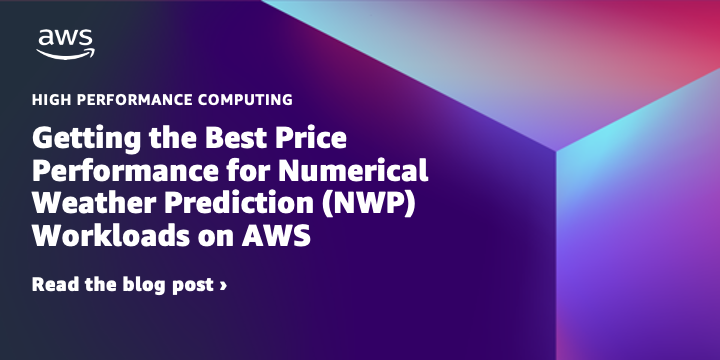AWS HPC Blog
Category: *Post Types
BioContainers are now available in Amazon ECR Public Gallery
Today we are excited to announce that all 9000+ applications provided by the BioContainers community are available within ECR Public Gallery! You don’t need an AWS account to access these images, but having one allows many more pulls to the internet, and unmetered usage within AWS. If you perform any sort of bioinformatics analysis on AWS, you should check it out!
Getting the Best Price Performance for Numerical Weather Prediction Workloads on AWS
In this post, we will provide an overview of Numerical Weather Prediction (NWP) workloads, and the AWS HPC-optimized services for it. We’ll test three popular NWP codes: WRF, MPAS, and FV3GFS.
Rearchitecting AWS Batch managed services to leverage AWS Fargate
AWS service teams continuously improve the underlying infrastructure and operations of managed services, and AWS Batch is no exception. The AWS Batch team recently moved most of their job scheduler fleet to a serverless infrastructure model leveraging AWS Fargate. I had a chance to sit with Devendra Chavan, Senior Software Development Engineer on the AWS Batch team, to discuss the move to AWS Fargate and its impact on the Batch managed scheduler service component.
Accelerating Genomics Pipelines Using Intel’s Open Omics Acceleration Framework on AWS
In this blog, we showcase the first version of Open Omics and benchmark three applications that are used in processing NGS data – sequence alignment tools BWA-MEM, minimap2, and single cell ATAC-Seq on Xeon-based Amazon Elastic Compute Cloud (Amazon EC2) Instances.
Building a Scalable Predictive Modeling Framework in AWS – Part 3
In this final part of this three-part blog series on building predictive models at scale in AWS, we will use the synthetic dataset and the models generated in the previous post to showcase the model updating and sensitivity analysis capabilities of the aws-do-pm framework.
Building a Scalable Predictive Modeling Framework in AWS – Part 2
In the first part of this three-part blog series, we introduced the aws-do-pm framework for building predictive models at scale in AWS. In this blog, we showcase a sample application for predicting the life of batteries in a fleet of electric vehicles, using the aws-do-pm framework.
Building a Scalable Predictive Modeling Framework in AWS – Part 1
Predictive models have powered the design and analysis of real-world systems such as jet engines, automobiles, and powerplants for decades. These models are used to provide insights on system performance and to run simulations, at a fraction of the cost compared to experiments with physical hardware. In this first post of three, we described the motivation and general architecture of the open-source aws-do-pm framework project for building predictive models at scale in AWS.
Running large-scale CFD fire simulations on AWS for Amazon.com
In this blog post, we discuss the AWS solution that Amazon’s construction division used to conduct large-scale CFD fire simulations as part of their Fire Strategy solutions to demonstrate safety and fire mitigation strategies. We outline the five key steps taken that resulted in simulation times that were 15-20x faster than previous on-premises architectures, reducing the time to complete from up to twenty-one days to less than one day.
Call for participation: RADIUSS Tutorial Series
Lawrence Livermore National Laboratory (LLNL) and AWS are joining forces to provide a training opportunity for emerging HPC tools and application. RADIUSS (Rapid Application Development via an Institutional Universal Software Stack) is a broad suite of open-source software projects originating from LLNL. Together we are hosting a tutorial series to give attendees hands-on experience with these cutting-edge technologies. Find out how to participate in these events in this blog post.
Understanding the AWS Batch termination process
In this blog post, we help you understand the AWS Batch job termination process and how you may take actions to gracefully terminate a job by capturing SIGTERM signal inside the application. It provides you with an efficient way to exit your Batch jobs. You also get to know about how job timeouts occur, and how the retry operation works with both traditional AWS Batch jobs and array jobs.









